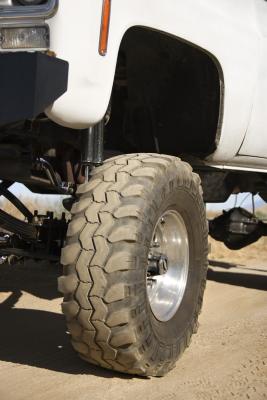
Taller tires are a favorite upgrade for many truck owners, but the increase in ground clearance and improvement in off-road performance they offer comes at a hefty premium in terms of vehicle dynamics. But it's a trade-off that many are willing to make, especially those wheeling rides that just don't look right with anything else.
Aspect ratio is the tire's tread width divided by the sidewall height, and it has a dramatic impact on vehicle dynamics. The average automobile uses tires with an aspect ratio of 40 or 50, meaning that the sidewall is 40 to 50 percent of the tread width. A 20 to 30 AR will sharpen handling, while ARs of 75 and above work best off-road. Going from 31- to 35- inch tires will increase AR by about 33 with 6-inch-wide tires, 25 with 8-inch tires and 20 with 10-inchers.
Larger-diameter tires travel further per revolution than smaller ones, which means that installing taller tires will affect your truck the same way installing numerically lower "economy" gears in place of numerically higher "acceleration" gears would. The 31-inch tires travel 97.34 inches per revolution as opposed to the 35-inchers' 109.9, which means a 13 percent numerical decrease in gear ratio. That means a 13 percent higher top speed but a concordant loss in torque to the wheels. Assuming that you started with a 350-horsepower engine and a truck weighing 4,000 pounds, the taller tires would likely add about 0.75-second to your quarter-mile time.
Your speedometer or vehicle control computer doesn't know you've changed the road inches traveled per tire revolution from 97.34 to 109.9, so it's going to spin the speedometer to the speed that it thinks you're going. Changing from 31-inch tires to 35-inch tires will cause your speedometer to read low: specifically, 17.4 miles per hour when you're actually doing 20, 39.15 mph when you're doing 45, 52.2 mph at 60 mph and 69.6 when you're going 80 mph.
The good news here is that you'll gain 2-inches of ground clearance when going with larger tires. The bad news is, well, everything else. That 2-inch increase in ground clearance increases your truck's aerodynamic profile, which negates the positive effects gleaned from that decrease in effective gear ratio. And the news gets worse, because the taller tires will allow more air to flow under the bottom of your chassis -- a neighborhood about as aero-efficient as the surface of the moon.
Two primary factors come into play where vehicle roll is concerned: center of gravity and suspension roll center. Think of the IC as the pivot on which your truck's chassis rolls and CG as a hand on the end of a lever. The closer the CG to the IC, the less the truck rolls. Increasing chassis height moves your CG further away from the IC, giving the chassis more mechanical leverage on the springs and shock absorbers. The resulting excess body roll won't play well with the increase in AR, and you'll likely end up with a truck that rolls like a barge at the slightest turning input and responds about as quickly to steering corrections.
This is something of a mixed bag. Taller tire sidewalls allow the tire to deform and flatten out more when encountering transitional lateral loads like acceleration and braking, which is part of the reason that people use them. If you drop air pressure low enough, the taller tires retain the capacity to flatten out like tank treads to grip the road surface -- and that's good. But taller tires also move the tread mass further away from the hub, increasing its polar moment of inertia. PMI is a measure of an object's resistance to changes in direction, acceleration and deceleration. The 35-inchers' higher PMI will have a negative impact on braking and acceleration on-road, but may not manifest off-road where you can drop the tires' air pressure to offset it.